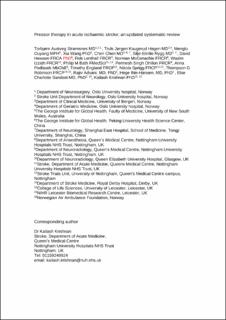| dc.contributor.author | Strømsnes, Torbjørn Austveg | |
| dc.contributor.author | Hagen, Truls Jørgen Kaugerud | |
| dc.contributor.author | Ouyang, Menglu | |
| dc.contributor.author | Wang, Xia | |
| dc.contributor.author | Chen, Chen | |
| dc.contributor.author | Rygg, Silje-Emilie Soltvedt | |
| dc.contributor.author | Hewson, David | |
| dc.contributor.author | Lenthall, Rob | |
| dc.contributor.author | McConachie, Norman | |
| dc.contributor.author | Izzath, Wazim | |
| dc.contributor.author | Bath, Philip M | |
| dc.contributor.author | Dhillon, Permesh Singh | |
| dc.contributor.author | Podlasek, Anna | |
| dc.contributor.author | England, Timothy | |
| dc.contributor.author | Sprigg, Nikola | |
| dc.contributor.author | Robinson, Thompson G | |
| dc.contributor.author | Advani, Rajiv | |
| dc.contributor.author | Ihle-Hansen, Hege | |
| dc.contributor.author | Sandset, Else Charlotte | |
| dc.contributor.author | Krishnan, Kailash | |
| dc.date.accessioned | 2023-04-24T12:37:44Z | |
| dc.date.available | 2023-04-24T12:37:44Z | |
| dc.date.created | 2022-05-26T14:48:57Z | |
| dc.date.issued | 2022 | |
| dc.identifier.issn | 2396-9873 | |
| dc.identifier.uri | https://hdl.handle.net/11250/3064528 | |
| dc.description.abstract | Background
Low blood pressure (BP) in acute ischaemic stroke (AIS) is associated with poor functional outcome, death, or severe disability. Increasing BP might benefit patients with post-stroke hypotension including those with potentially salvageable ischaemic penumbra. This updated systematic review considers the present evidence regarding the use of vasopressors in AIS.
Methods
We searched the Cochrane Database of Systematic Reviews, MEDLINE, EMBASE and trial databases using a structured search strategy. We examined reference lists of relevant publications for additional studies examining BP elevation in AIS.
Results
We included 27 studies involving 1886 patients. Nine studies assessed increasing BP during acute reperfusion therapy (intravenous thrombolysis, mechanical thrombectomy, intra-arterial thrombolysis or combined). Eighteen studies tested BP elevation alone. Phenylephrine was the most commonly used agent to increase BP (n = 16 studies), followed by norepinephrine (n = 6), epinephrine (n = 3) and dopamine (n = 2). Because of small patient numbers and study heterogeneity, a meta-analysis was not possible. Overall, BP elevation was feasible in patients with fluctuating or worsening neurological symptoms, large vessel occlusion with labile BP, sustained post-stroke hypotension and ineligible for intravenous thrombolysis or after acute reperfusion therapy. The effects on functional outcomes were largely unknown and close monitoring is advised if such intervention is undertaken.
Conclusion
Although theoretical arguments support increasing BP to improve cerebral blood flow and sustain the ischaemic penumbra in selected AIS patients, the data are limited and results largely inconclusive. Large, randomised controlled trials are needed to identify the optimal BP target, agent, duration of treatment and effects on clinical outcomes. | en_US |
| dc.language.iso | eng | en_US |
| dc.title | Pressor therapy in acute ischaemic stroke: an updated systematic review | en_US |
| dc.type | Journal article | en_US |
| dc.type | Peer reviewed | en_US |
| dc.description.version | acceptedVersion | en_US |
| dc.rights.holder | Copyright 2022 The Author(s) | en_US |
| cristin.ispublished | true | |
| cristin.fulltext | postprint | |
| cristin.qualitycode | 1 | |
| dc.identifier.doi | 10.1177/23969873221078136 | |
| dc.identifier.cristin | 2027577 | |
| dc.source.journal | European Stroke Journal | en_US |
| dc.source.pagenumber | 99-116 | en_US |
| dc.identifier.citation | European Stroke Journal. 2022, 7 (2), 99-116. | en_US |
| dc.source.volume | 7 | en_US |
| dc.source.issue | 2 | en_US |
